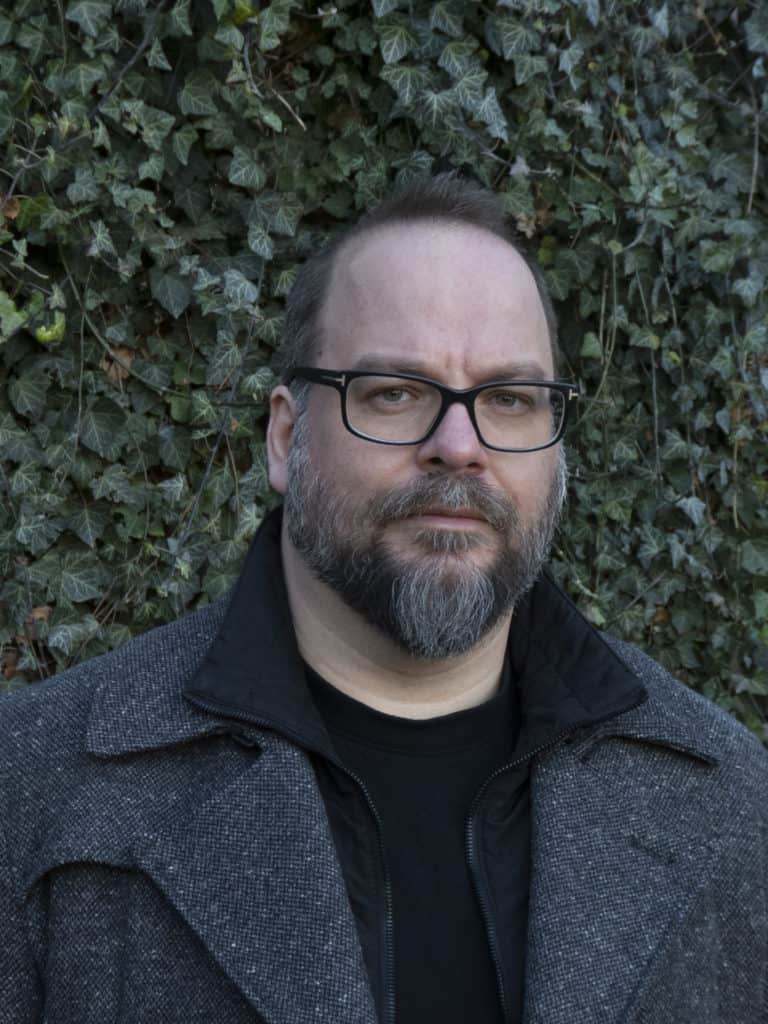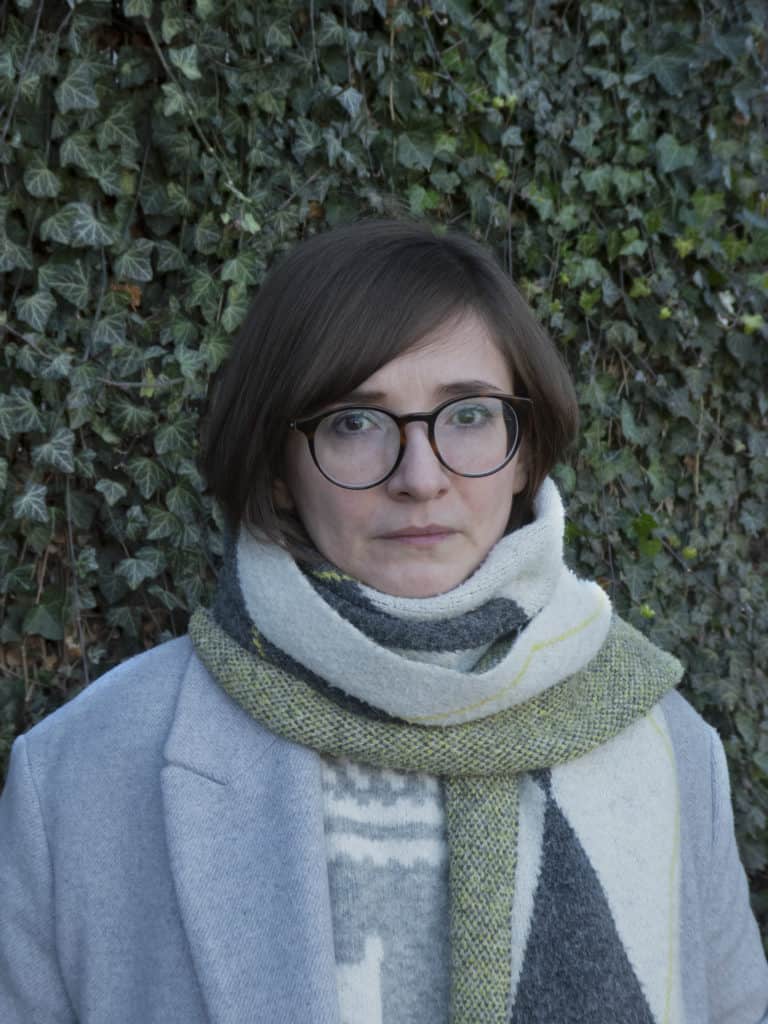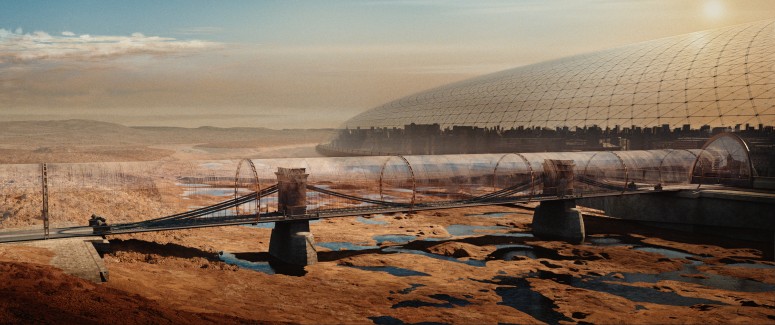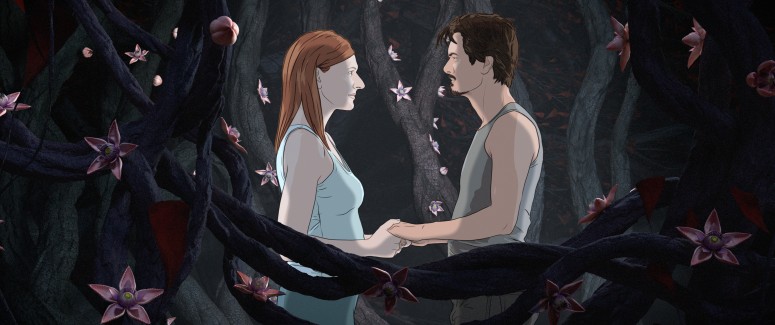I saw White Plastic Sky in the Berlinale Encounters section, and afterwards, I had the opportunity to interview the directors Sarolta Szabó and Tibor Bánóczki. We talked about the problems with the production, as well as the themes and the visuals of the film.
The first question is about a tiny detail. I read an old description of the film, which stated that the film takes place in 2200. The finalised film takes place in 2123. Was there any specific reason for that change, or does the year 2123 have any special significance? And also, generally, how did the project come into being?
Sarolta Szabó: Yes, eventually, we concluded that it would be better if the film was not set too far in the future. It would be easier for the audience to relate to a year not that far away. We wanted to be cruel to the spectator in a way, and that would work better if the film was set in a year when their grandchildren were alive.
Tibor: It’s also true that the world has changed so much in the last seven years. Apart from the increasingly rapid climate change, there is also the pandemic and the war in Ukraine. Sure, the war started long before, but it’s now on a full scale. It’s a bit of a dystopic in itself. So during the process of making the film, the world has changed, and I think that the future we present in the film is even closer than we thought.
Yes, unfortunately. Maybe, the film will feel retro in two years.
Tibor: Maybe, yes. (laughing)
The oldest texts I found about the film said, “premiere in 2019”, so I guess the project has been delayed for different reasons.
Sarolta: Yes, because it started in the Incubator program, designed for very low-budget films. We continued to look for co-producers to secure additional funds, and with help from other partners, we could raise the budget.


I saw that even Proton Cinema 1Proton Cinema is a film company highly associated with the films of Kornél Mundruczó. was involved. Viktória Petrányi is mentioned in the credits.
Tibor: Yes, Viktória was a kind of an advisor for a lot of things, and she was a big help. When we started, there was such a small crew and little money, and then the Film Fund set a deadline. Then they realised it wasn’t possible, so the film was delayed and delayed. In the Western world, you spend a long time getting the budget, and when you have the money, you start production.
Sarolta: And then you know your budget and what you have to work with.
And the Film Fund system changed quite a bit, to say the least.
Tibor: Yes, it changed a lot. We started in a different era.
But you were still able to get the funds through the new system?
Tibor: We had a promise from the old fund that it would be lifted out of the Incubator program and given a bit more money, and that promise was kept.
The themes of White Plastic Sky
Tibor: We were thinking about questions like what are the most important things for the planet. Is it human life or any life? Would it be the same planet if humanity would be wiped out and there were only animals and nature? Or is it inevitable that we are the crown of the planet and that any kind of civilisation will eat itself? We can’t do anything about it, so maybe we shouldn’t worry about climate change since it’s unavoidable. Many sci-fi writers feel that way. The theme of metamorphosis is ancient. We were inspired by Philemon and Baucis, also Dante’s hell and Ovid’s Metamorphosis. Also, around seven years ago, scientists started to discover how trees communicate.
Sarolta: Like in The Secret Life of Trees.
And you talked to scientists during the research period, right?
Sarolta: Yes, we talked to scientists and collected information. We collected everything they told us, but we didn’t follow it too closely.
Tibor: Probably, the most important thing was about the oxygen. If we wipe out all the plants, where would the oxygen come from? The fact is that there is lots of oxygen, even without plants. It depends on how many people would stay. So people wouldn’t necessarily suffocate. There were discussions about if one city is isolated, how would it be able to support itself?

Talking about cities, the film is set in Budapest, but also in Miskolc. Why is that? Is it because it’s an industrialised city with lots of pollution, or something else?
Sarolta: It’s not so typical to choose Miskolc.
Well, there is A miskolci boniésklájd.
Sarolta: When we had the idea that they would go to the Tatras, it was clear that they should go towards Miskolc…
Well, they could have gone to Sárosptak.2 Tibor’s hometown.
Sarolta: Yes, TIbor has a connection to this part of the country, and we thought it would be interesting to put one of the biggest but not the sexiest city on the science fiction map in Hungary.
Was it also because it is one of the most industrialised cities in Hungary?
Tibor: Well, now many of those industries are gone, so it wasn’t about that. We felt that because I have lots of connections to that part of Hungary. In an American movie, you could use Cleveland, so why couldn’t we use Miskolc?
Initially, while watching the film, I was thinking about Ágnes Kocsis’ Éden, maybe because of the dome, but it’s a film about the environment, as well. More about how a person adapts (or not) to the environment, but still. How do you read your film? Is it a film about mankind, or is it more of a philosophical work?
Tibor: We hope that the philosophical themes shine through.
Sarolta: For us, the most important thing was to talk about sacrifice, about love and family. We wanted to tell this dystopian story but make it human. We wanted to be able to give the audience the opportunity to engage with the characters but to think about humanity at the same time and maybe bring it to another life form.
Tibor: Also, if we talk about similarities, there are lots of Science fiction that have the same themes and images like the dome and the deserted planet. You have films like Soylent Green (1973), but we believe (or hope) that each film has a different core idea, even if we use the same iconography. It’s difficult to make something completely new in Science fiction, but we can refine the ideas, and hopefully, it will still feel fresh.

The look of White Plastic Sky
I saw the film on a big screen yesterday, and it looks stunning. How did you approach the visuals? Both from an artistic perspective, but also the technical with the rotoscope and so on.
Tibor: We made storyboards of everything. We also had an advisor who helped us a lot with the framing and composition. Then we collaborated with concept designers. The difference with live-action shooting is that it’s easy to change things even before the animation begins.
Sarolta: So, before the editing, we could change lots of things, and we could test and find the best solution.
Tibor: It’s a very organic process. You try things, and you can change a lot.
Technology has changed. After all, Rotoscope is a very old technique.
Tibor: With the rotoscope, we used the simplest technique, and everything was hand-drawn.
Everything? Not the cityscapes and the backgrounds?
No, just the main characters. Not the myriad of characters in the background.
Once again, the interview was interrupted before I could get into Marvel Movies.